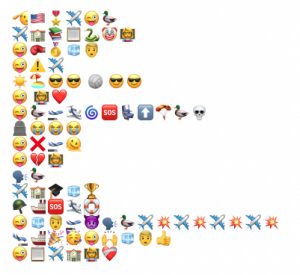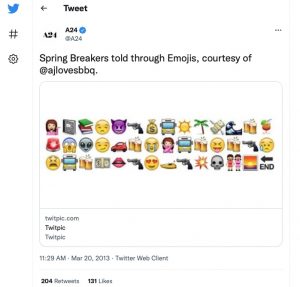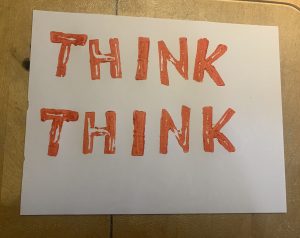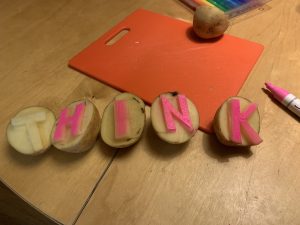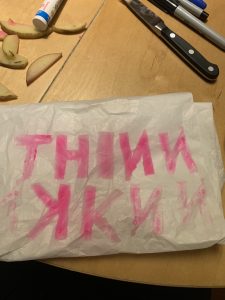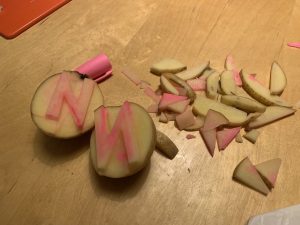Voice to Text
For this task, I used Google Docs’ voice-to-text functionality. I attempted to recount a story about my youngest child (Jax, they/them pronouns), and their path to a dyslexia diagnosis. They have a dedicated laptop at school, and they are encouraged to use voice-to-text technology in the classroom, so this assignment has some personal meaning to me. I approached this story as if I were telling it to a friend who suspects their child might have a learning disability. Here is the written text of the story as produced by Google Docs:
I’m going to tell you a story about my youngest child and our experience with them when they were diagnosed with dyslexia my youngest their name is Jax was first we first noticed that they had some difficulty with reading when they were little very low our oldest child could read at a very early age like 3 so you kind of expect your second born to have the same experience and while we had the same parenting approach to our second born we read them a lot talked them a lot language followed all those things parents are encouraged to do to encourage the love of literacy we notice that Jack’s was not reading and at first I was like well you know my oldest one Charlie was an early readers so maybe our expectations are just High But as time went on we noticed that even though Jack’s loved to be red 2 love reading loved books left holding them and flipping through the pages love listening being Red 2 they weren’t at the same thing keeping up with their peers in terms of reading so and they were also in French immersion which we were told go well they’re just not reading in French of appropriate level that’s okay they’re not supposed to be it’s not it’s not the same as being an English to French reading will like behind because it’s a different language and we didn’t speak French at home but we did notice that when Jack’s red they would read they could memorize Sight Words Their process of reading was looking at a word and if they could recognize if we were repeated locksmiths in it then they could read quote on quote those words but when it came to sounding a new words they just could not do it they would just give up and guess so we had them privately tested and indeed they were diagnosed with dyslexia in terms of the type of Dyslexia is a specific kind called decode what was going on in Jackson spring is they did not associate letters and letter sounds appropriately so that meant you no sounding Out new words was was an impossible task so what we have done is we had some private tutoring expensive tutoring to basically reinforced letter sounds and it’s actually been quite effective I’ve been very impressed actually with that program but it was it’s our it was hours and hours a week since yours actually of of that directed reading program it has been very helpful and Jack’s can read not necessarily act appropriate grade level but has made great strides and actually will take up a book and read it but they also still have a love of listening to books audio books which I think is just as the legitimate form of reading as any as any other they also in terms of compensating for this before we haven’t officially diagnosed Jackson’s very social and very outgoing and very very verbal scored above their their peers in terms of verbal ability and reasoning ability their memory skills that they have sharp memory they were coughing so accurately that I do not know which is the function of age I think but also I think compensation for not being able to or not having writing ability but when they can no longer hide it when they proceeded in schools are now in grades 7 and they were required to right it’s more difficult and they do not want to use assistive technology even though it’s there even though this voice to text exist for them and they have access to a laptop to use in the classroom they do not want to use it they don’t want to appear different and I don’t want to seem like they need help in any way which I understand but it’s also very frustrating cuz we’re just trying to help them and this technology should help them but what do you do when there’s a stigma to using it
How does the text deviate from conventions of written English?
This isn’t a story that I would normally write down. It is an informal retelling of a personal experience, and as such, it lacks the clear structure and flow I would expect from written English. Since time was my limit, I just stopped talking when I saw five minutes on my timer; there is no concluding statement or summary. However, the most significant deviation from written English is the absence of consistent capitalization, punctuation, sentences, and paragraph structure. I tried to pause to indicate the end of a sentence, but you need to dictate punctuation in Google Docs (as I found out later from a helpful Google cue). As a result, much of the meaning is lost, and the story I’m trying to tell is difficult to follow. I would edit out all of the repeated words, and “I was like well you know” and “quote on quote,” which was me saying “quote unquote” and making air quotes at the same time.
What is “wrong” in the text? What is “right”?
I was surprised to see that my child’s name was correctly transcribed as “Jax” in the first instance and then incorrectly transcribed as “Jack’s” or “Jackson’s” throughout the rest of the text. That could be due to poor enunciation on my part, but hearing “Jack” instead of “Jax” is a common mistake, even with in-person introductions. Also, “cuz” instead of “because” really jumps out at me as a glaring error.
While I would consider it “wrong,” Google Docs accurately captured my tendency to repeat words. I was using “very” for oral emphasis, but when you see that word repeated in text, it loses its impact and seems like lazy sentence construction. And while I am positive that I used filler “um”s at least a couple of times while I was telling the story, they are nowhere to be found in the text. I went back to Google Docs to test this on voice-to-text, and it did not record even when I said “um” and “ah” very clearly into the microphone. In that case, the text is “right” because the machine has edited out the filler words that are not needed in the written text. But is it also “wrong” because it didn’t capture what I actually said. You would have to consider the objective of this text: is it to take a verbal story and convert it into a conventional written form? Or is it to accurately capture an oral account in writing, even with all its filler words, pauses, and ramblings?
What are the most common “mistakes” in the text and why do you consider them “mistakes”?
The most common mistakes are inconsistent capitalizations (dyslexia is both capitalized and lower case) and problems with homophones (red/read, 2/to), but the meaning is still intact. However, there are a few instances where the translation is nonsensical and meaning is lost entirely (e.g. I have no idea what “if we were repeated locksmiths in” means, even with the surrounding context).
What if you had “scripted” the story? What difference might that have made?
I really had to fight the urge to script the story! But then again, I am the kind of person who will write out scripts in advance of difficult phone or video conversations. If I had scripted the story, the output would be radically different. I would still tell the story of my child’s dyslexia diagnosis, but it would have a better structure. I would have an introduction, a linear timeline of events (perhaps with more context), and a conclusion. I would narrate all punctuation and line breaks so the output would be more precise. By having a script to read from, there would be fewer redundancies, no inserted air quotes, not so many “so’s” and “likes” and repeated words. I could communicate my story and ensure that the voice-to-text output would be readable and clear. I could rehearse the script and ensure it would fit into a five-minute timeline and edit or adjust accordingly before recording. I would still try to keep the story informal and conversational, however. I wouldn’t want to turn it into a dry retelling of facts and events.
In what ways does oral storytelling differ from written storytelling?
So much depends on the oral storyteller, their memory, and how they tell their stories: their intonation, animation, and connection to the audience. In his lecture on Oral Cultures and Early Writing, Ong states that no oral culture can recite things verbatim. Every time it is a bit different. (Aboud 2014). When you write down a story, the “writing takes words and turns them into objects . . . written down, words remain on the page like butterflies stuck onto boards with pins. They can be examined, analyzed, and dissected. They can be pointed to and discussed. Spoken words, by contrast, are inherently ephemeral” (Gnanadesikan, 2009, p. 4).
References
Aboud, A. [Abe Aboud]. (2014, September 4). Walter Ong – Oral Cultures and Early Writing [Video]. YouTube. https://youtu.be/uvF30zFImuo
Gnanadesikan, A. E. (2009).“The First IT Revolution.” In The writing revolution: Cuneiform to the internet (Vol. 25, pp. 1-10). John Wiley & Sons.
 Plot
Plot